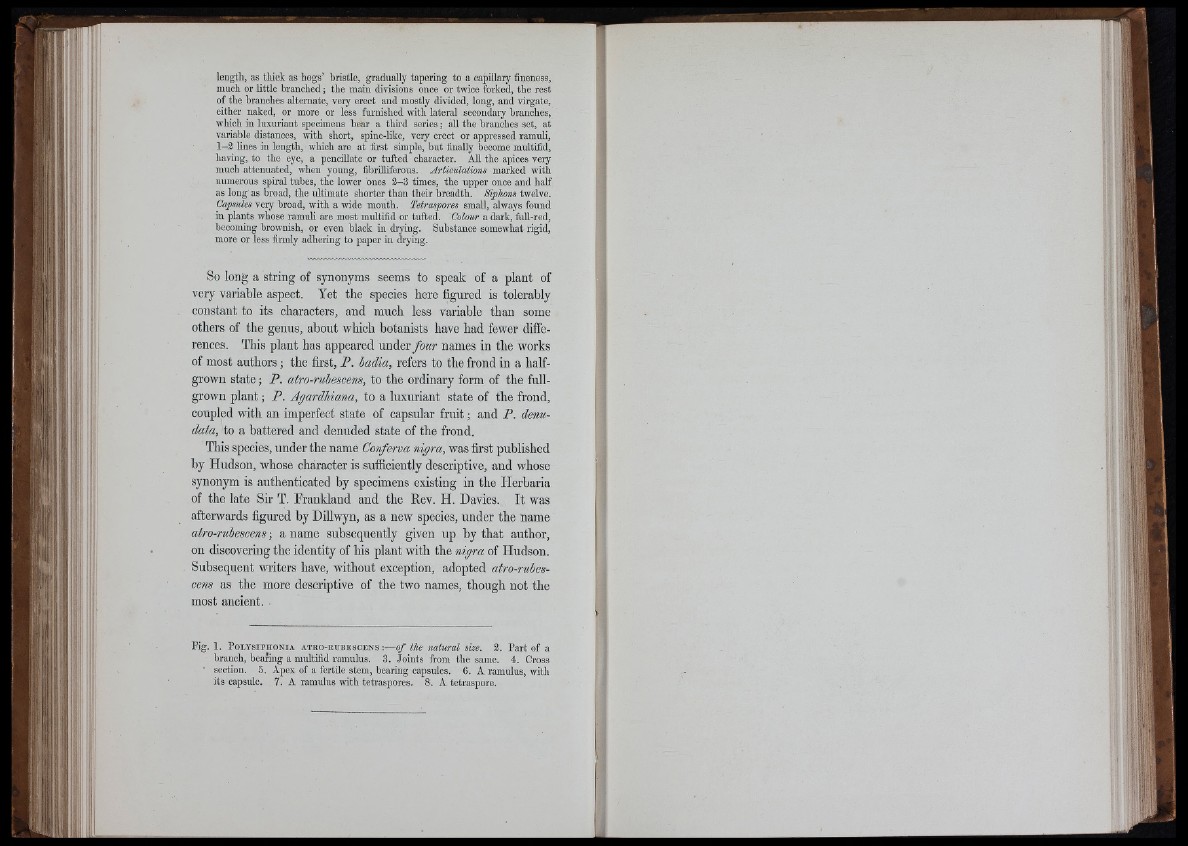
length, as thick as hogs’ bristle, gradually tapering to a capillary fineness,
much or little branched ; the main divisions once or twice forked, the rest
of the branches alternate, very erect and mostly divided, long, and virgate,
either naked, or more or less furnished with lateral secondai-y branches,
which in luxuriant specimens hear a third series ; all the branches set, at
variable distances, with short, spine-like, very erect or appressed ramnli,
1-3 lines in length, which are at first simple, but finally become multifid,
having, to the eye, a penciUate or tufted character. All the apices very
much attenuated, when young, fihriHiferous. Articulations marked with
numerous spiral tubes, the lower ones 3-3 times, the upper once and half
as long as broad, the ultimate shorter than their breadth. Siphons twelve.
Capsules very broad, with a wide mouth. Tetraspores small, always found
in plants whose ramuli are most multifid or tufted. Colour a dark, full-red,
becoming brownish, or even black in drying. Substance somewhat rigid,
more or less firmly adhering to paper in diying.
So long a string of synonyms seems to speak of a plant of
very variable aspect. Yet tbe species bere figured is tolerably
constant to its characters, and mucb less variable tban some
others of tbe genus, about which botanists have bad fewer differences.
This plant has appeared under four names in the works
of most authors ; the first, P. badia, refers to the frond in a halfgrown
state ; P. atro-rubescens, to tbe ordinary form of tbe full-
grown plant ; P. Agardhiana, to a luxuriant state of the frond,
coupled witb an imperfect state of capsular fruit ; and P. denudata,
to a battered and denuded state of tbe frond.
This species, under the name Conferva nigra, was first published
by Hudson, whose character is sufficiently descriptive, and whose
synonym is authenticated by specimens existing in tbe Herbaria
of the late Sir T. Erankland and the Rev. H. Davies. It was
afterwards figured by Dillwyn, as a new species, under the name
atro-rubescens ; a name subsequently given up by that author,
on discovering the identity of his plant with the nigra of Hudson.
Subsequent writers have, without exception, adopted atro-rubescens
as tbe more descriptive of the two names, though not the
most ancient.
i i â
Kg. 1. P olysiphonia ateo-bubescens -.— o f the natural size. 3. P a rt of a
branch, bearing a multifid ramulus. 3. Joints from the same. 4. Cross
■ section. 5, Apex of a fertile stem, hearing capsules. 6. A ramulus, with
its capsule. 7. A ramulus with tetraspores. 8. A tetraspore.